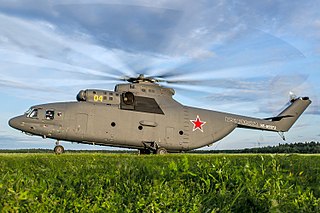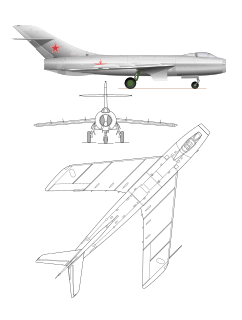
The Mil Mi-24 is a large helicopter gunship, attack helicopter and low-capacity troop transport with room for eight passengers. It is produced by Mil Moscow Helicopter Plant and has been operated since 1972 by the Soviet Air Force and its successors, along with more than 30 other nations.

The Mikoyan-Gurevich MiG-8 Utka was a Soviet experimental aircraft. Built of wood, the aircraft was designed and built in 1945 to test the novel canard configuration. It also used a tricycle undercarriage, the first used by the OKB. It was modified to test a variety of vertical stabilizer and wingtip configurations and was later used as a liaison aircraft for many years by the design bureau.

The Mil Mi-8 is a medium twin-turbine helicopter, originally designed by the Soviet Union, and now produced by Russia. In addition to its most common role as a transport helicopter, the Mi-8 is also used as an airborne command post, armed gunship, and reconnaissance platform. Along with the related, more powerful Mil Mi-17, the Mi-8 is among the world's most-produced helicopters, used by over 50 countries. As of 2015, it is the third most common operational military aircraft in the world.

The Yakovlev Yak-24 is a Soviet twin-engine, tandem rotor, transport helicopter developed by Yakovlev in the 1950s. The Yak-24 saw limited use in the Soviet Air Force, and the exact number produced and duration of service are unknown due to inconsistencies in data.

The Mil Mi-28 is a Russian all-weather, day-night, military tandem, two-seat anti-armor attack helicopter. It is an attack helicopter with no intended secondary transport capability, better optimized than the Mil Mi-24 gunship for the role. It carries a single gun in an undernose barbette, plus external loads carried on pylons beneath stub wings.

The Mil Mi-17 is a Soviet/Russian helicopter in production at two factories in Kazan and Ulan-Ude. It is known as the Mi-8M series in Russian service. It is a medium twin-turbine transport helicopter. There are also armed gunship versions.

The Mil Mi-14 is a Soviet shore-based nuclear-capable amphibious anti-submarine helicopter derived from the earlier Mi-8.

The Mil Mi-26 is a Soviet/Russian heavy transport helicopter. Its product code is izdeliye 90. Operated by both military and civilian operators, it is the largest and most powerful helicopter to have gone into series production.

OPK Oboronprom was a Russian aerospace holding company. The company was involved in helicopter production, engine production, air-defenсe systems, complex radio-electronic systems and leasing. Russian Helicopters, Oboronprom’s helicopter manufacturing group is the leading Russian designer and manufacturer of rotary-wing aircraft equipment.

The Central Air Force Museum is an aviation museum in Monino, Moscow Oblast, Russia. A branch of the Central Armed Forces Museum, it is one of the world's largest aviation museums, and the largest for Soviet aircraft, with a collection including 173 aircraft and 127 aircraft engines on display. The museum also features additional displays, including Cold War-era American espionage equipment, weapons, instruments, uniforms, artwork, and a library containing books, films, and photos is also accessible to visitors.

Spichenkovo Airport, also known as Novokuznetsk Airport, is one of two major airports in Kemerovo Oblast area, Russia, Southwestern Siberia located 17 km west of Novokuznetsk. It is named after the nearby town of Spichenkovo. The area has skiing resorts, and the airport is the place where Russian holiday makers pass through arriving to Mezhdurechensk, Kemerovo Oblast.

The Sukhoi Su-17 was a prototype Soviet fighter. The name was later reused for an entirely different fighter-bomber, see Sukhoi Su-17.

The Tupolev ANT-25 was a Soviet long-range experimental aircraft which was also tried as a bomber. First constructed in 1933, it was used by the Soviet Union for a number of record-breaking flights.
The Mil Mi-22 was a Soviet single-engined helicopter project of the 1960s. It resembled the Mil Mi-2 in size and shape and had problems with planned engine configuration Later schematics interested the Russian military with illustrations of a higher-capacity engine configuration, 10A GTD-940 kW to be precise, and had an improved fuselage, unlike the earlier Mil Mi-2. It was also planned to have a four-bladed main rotor, a two-bladed tail rotor, a larger cabin than that in the Mil Mi-2, and a skid undercarriage. The Mi-22 lost out to the larger Mi-24, which had better assault/transport abilities.
The Mil Mi-30 is an experimental Russian plane/helicopter that originated in 1972. The Mil Mi-30 Vintoplan was a transport aircraft that could hold up to 19 passengers or two tons of cargo; its purpose was to replace the Mi-8 and Mi-17 Helicopters. With vertical takeoff and the ability to fly like a normal plane, the Mil Mi-30 has a clear advantage over the older models.
The Yakovlev EG, also commonly known as the Yak-M11FR-1 and Sh (Shootka), was an experimental aircraft with coaxial rotors. The prototype was first flown by V.V. Tezavrovsky in December 1947.

The Klimov TV3-117 is a Russian gas turbine aero engine. It is used in most medium lift, utility, and attack helicopters designed by the Mil and Kamov design bureaus. The TV3-117 turboshaft engine was developed in 1974. Later the Klimov TV3-117 was installed on 95% of all helicopters designed by Mil and Kamov Engineering Centre. The engine has been produced in many variants.

The Klimov TV7-117 is a Russian turboprop engine certified in 1997 to power the Ilyushin Il-114 regional commuter aircraft. The new engine features enhanced reliability, fuel economy and greater service life compared to its predecessors produced in the former Soviet Union. The engine has a modular design. The nine modules can be replaced in the field, which dramatically reduces costs and accelerates repair and maintenance. The engine has an electronic-hydromechanical control system.
JSC Russian Helicopters is a helicopter design and manufacturing company headquartered in Moscow, Russia. The company designs and manufactures civilian and military helicopters. The company's principal shareholder is Rostec. It is the world's 24th-largest defence contractor measured by 2012 defence revenues, and the second-largest based in Russia.















